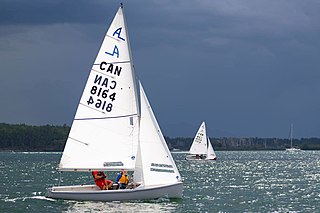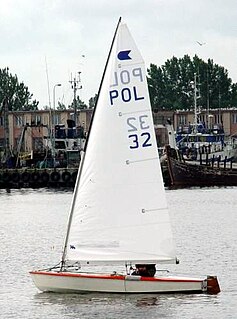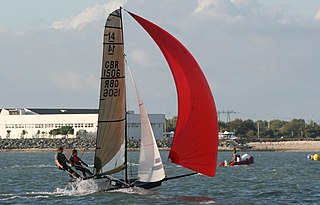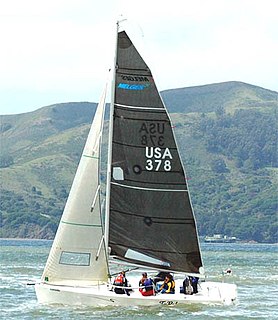Manly Junior  Two boys on their Manly Junior + |
|
| Designer | Ralph Tobias |
|---|
| Location | Sydney, Australia |
|---|
| Year | 1959 |
|---|
| Role | Junior trainer |
|---|
|
| Crew | 2 |
|---|
|
| Construction | Plywood, Fiberglass |
|---|
| Hull weight | 31.75 kilograms (70.0 lb) |
|---|
| LOA | 2.6 metres (8.5 ft) |
|---|
| Beam | 1.1 metres (3.6 ft) |
|---|
|
| Mainsail area | 4.1 square metres (44 sq ft) |
|---|
| Jib/genoa area | 1.2 square metres (13 sq ft) |
|---|
| Spinnaker area | 2.1 square metres (23 sq ft) |
|---|
|
The Manly Junior is a junior racing dinghy class popular in Sydney Australia. It was designed in 1959 for younger sailors and the length (2.6 m) was originally designed so that the boat could be stored vertically downstairs inside Manly Yacht Club (the founding club). To provide as much performance as possible in a short length, the designer, Ralph Tobias used a "snub" bow.
Typically the helmsman is aged 10~14 and the crew 7~11 years old. It is amongst the smallest of classes with a "full rig": mainsail, jib and spinnaker. The class has a strict set of rules on sail size, shape and hull construction. Some variation is allowed in the details of how the boat is rigged (position of fittings etc.).
The class has made some significant changes since inception, in 1967 the buoyancy tanks were redesigned to allow the boat to come up after a capsize with little water on board. In the 1980s the class underwent a transition from plywood to fibreglass hulls. In 2000 false floors were added allowing the boat to completely drain of water after a capsize or swamping.
Racing is competitive with many previous sailors going on to become world or Olympic Games champions in other classes. The skill level shown at a State or National event is high with racing being completed in up to 30 knots (56 km/h) of wind.
Many children however join in for the social side. Sometimes you will get two 11-year-old friends match up to have fun while learning. Other times the younger children look up to the older children as "heroes". Club racing is often like a friendly "family" where the focus is on learning. Even at major events "Novice" (learning) fleets allow the less experienced to compete and enjoy the fun.
As the sailors grow they often move onto Flying Eleven (dinghy), 420 (dinghy) or laser dinghy.
A quick count would suggest over 30,000 children have been introduced to sailing via the Manly Junior fleet.

Dinghy sailing is the activity of sailing small boats by using five essential controls:
The Mirror is a popular sailing dinghy with more than 70,000 built.

Dinghy racing is a competitive sport using dinghies, which are small boats which may be rowboats, have an outboard motor, or be sailing dinghies. Dinghy racing has affected aspects of the modern sailing dinghy, including hull design, sail materials and sailplan, and techniques such as planing and trapezing.

The Albacore is a 4.57 m (15 ft) two-person planing dinghy, for competitive racing and lake and near-inshore day sailing. Hulls are made of either wood or fiberglass. The basic shape was developed in 1954 from an Uffa Fox design, the Swordfish. Recent boats retain the same classic dimensions, and use modern materials and modern control systems, making it ideal for the recently graduated college racer, as well as those with less experience.

The Wayfarer is a wooden or fibreglass hulled fractional Bermuda rigged sailing dinghy of great versatility; used for short 'day boat' trips, longer cruises and for racing. Over 11,000 have been produced as of 2016.

The Optimist, also known as the ‘opti’, or 'oppie', is a small, single-handed sailing dinghy intended for use by children and teenagers up to the age of 15. Contemporary boats are usually made of fibreglass, although wooden boats are still built.

The International 420 Dinghy is a sailing dinghy popular for racing and teaching. The hull is fiberglass with internal buoyancy tanks. The 420 has a bermuda rig and an optional spinnaker and trapeze. It has a large sail-area-to-weight ratio, and is designed to plane easily. It can be rigged to be sailed single-handed or double-handed. The 420 is an International class recognized by World Sailing. The name refers to the boat's length of 420 centimetres.

The Sunfish is a personal-size, beach-launched sailing dinghy. It features a very flat, boardlike hull carrying a lateen sail sail mounted to an un-stayed mast.

The OK Dinghy is an international class sailing dinghy, designed by Knud Olsen in 1956.

The Cadet is a class of sailing dinghy designed to be sailed by two children up to the age of 17. It is a one-design class, originally designed by Jack Holt in 1947. Cadets are sailed worldwide in more than 40 countries.
The International Offshore Rule (IOR) was a measurement rule for racing sailboats. The IOR evolved from the Cruising Club of America (CCA) rule for racer/cruisers and the Royal Ocean Racing Club (RORC) rule.

The 18 ft Skiff is considered the fastest class of sailing skiffs. The class has a long history beginning with races on Sydney Harbour, Australia in 1892 and later in New Zealand. The boat has changed significantly since the early days, bringing in new technology as it became available. Because of the need of strength, agility and skill, the class is considered to be the top level of small boat sailing. In Australia this boat is called the "Aussie 18" due to its inherent connections to Australia. It is the fastest conventional non-foiling monohull on the yardstick rating, with a score of 675, coming only third after the Tornado and Inter 20.

The International 14 is a 14-foot double-handed racing dinghy. The class originated in England in the early part of the 20th century. It is sailed and raced in many countries around the world and was one of the first true international racing dinghy classes recognised by International Sailing Federation. It is a development class, being controlled by a set of rules that allow for innovation and changes in hull and rig design as long as they fall within a set of specific limitations such as length, weight, beam, and sail area. The class has permitted its rules to be revised at various times in its history in order to keep the class at the forefront of dinghy racing development and can now best be described as an ultralight dual-trapeze sailing dinghy with large sail area. It is often raced with boats of similar design in one-design, or non-handicap races.

The Moth is a small development class of sailing dinghy. Originally a small, fast home-built sailing boat designed to plane, since 2000 it has become an expensive and largely commercially-produced boat designed to hydroplane on foils.
The P-Class is a type of small single sail dinghy, popular as a training boat for young people in New Zealand. This class is famous for being the sailing trainer vessel for many new entrants into the sport, and virtually every famous New Zealand yachtsman, including Sir Peter Blake and Russell Coutts, learnt to sail in one. The P-Class was for many years the most common sailing boat in New Zealand.

The term sportsboat first appeared in the late 1980s and early 1990s to describe trailer sailers that were optimised for high performance at the expense of accommodation and ballast. The very definition of the term "sportsboat" is evolving.
The Naples Sabot is an 8-foot (2.4 m) sailing dinghy. The Naples Sabot was designed by Roy McCullough and R.A. Violette and the first two were built in Violette's garage during WW II, although official designs were not made available until 1946. The Naples Sabot is based on the Balboa Dinghy and on Charles MacGregor's Sabot as published in Rudder magazine, April 1939. It takes its name from Naples in Long Beach, California, where it was developed.

The RS Tera is a one-man monohull dinghy in the RS Sailing range of sailing boats. It is recognised by the International Sailing Federation (ISAF) as an international class, and is a popular boat for beginners and for children to race.

The Nippa is a small Australian dinghy designed by Iain Murray in 2004. The Nippa dinghy was designed for young sailors between five and fourteen years of age, or a young sailor and instructor. Its open back design was to provide easy movement as well as a self-bailing feature.
The Firebug is a class of sailing dinghy that was designed by John Spencer and Peter Tait of Auckland, New Zealand in 1995. It is a 2.4 m long sailing dinghy designed to be built quickly and easily by builders with no previous experience of boatbuilding. A detailed report was published in Watercraft Magazine.















